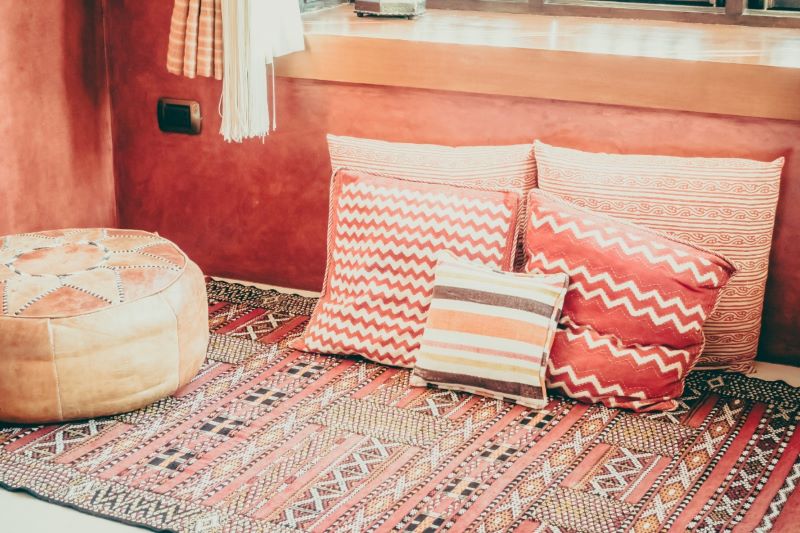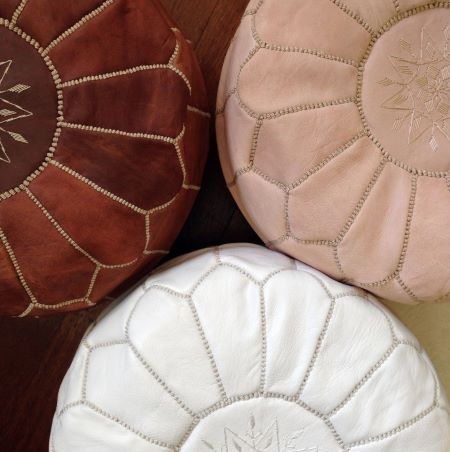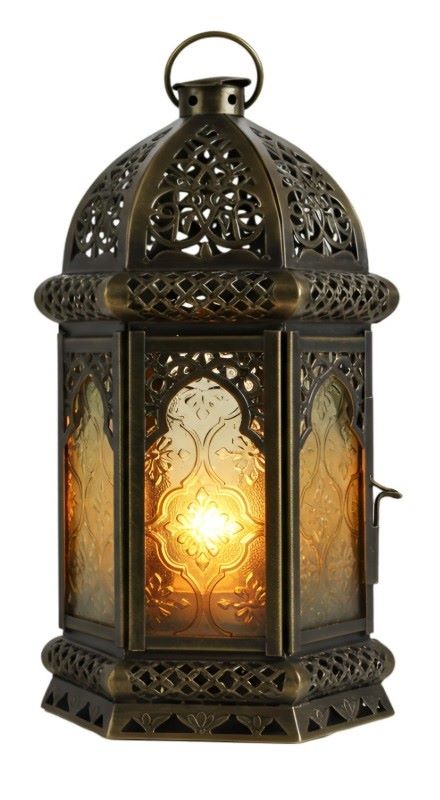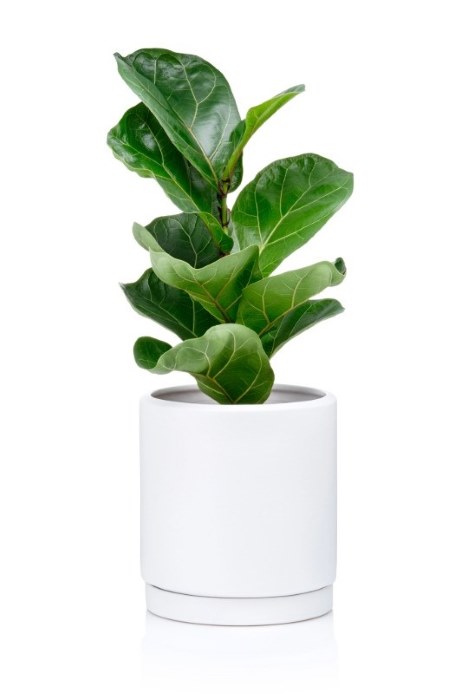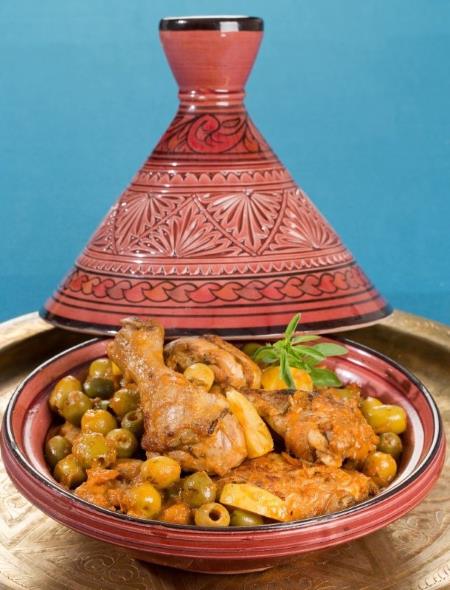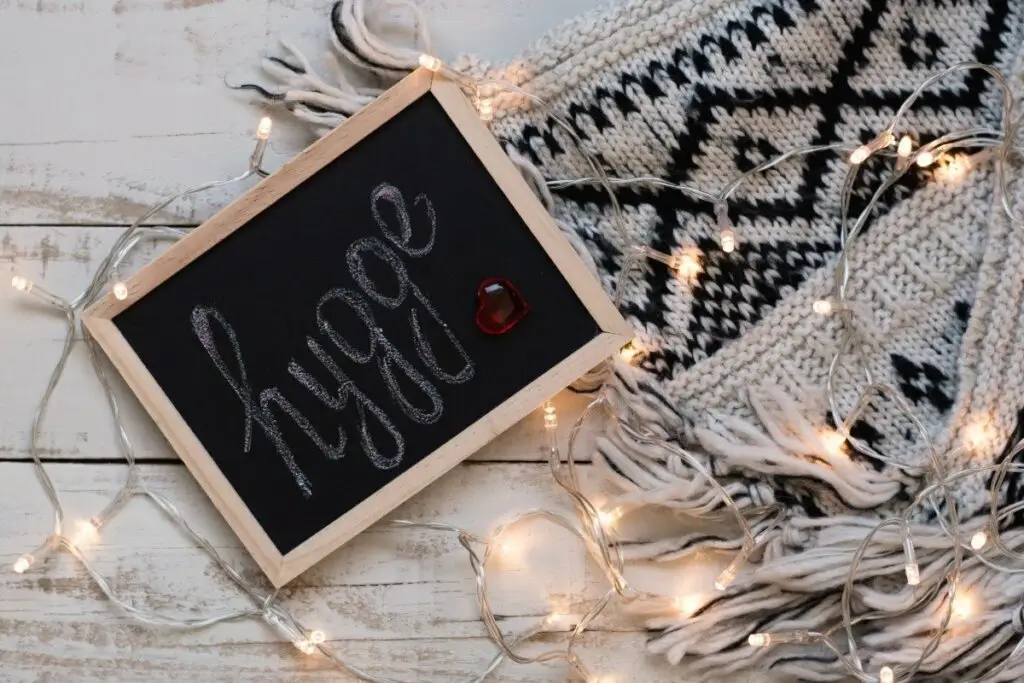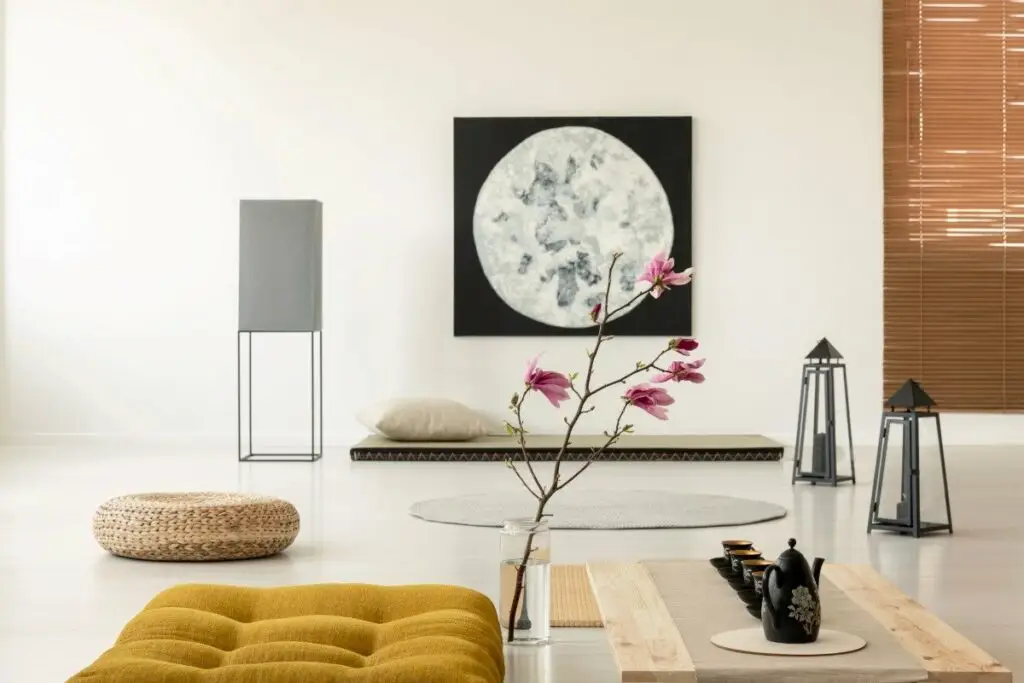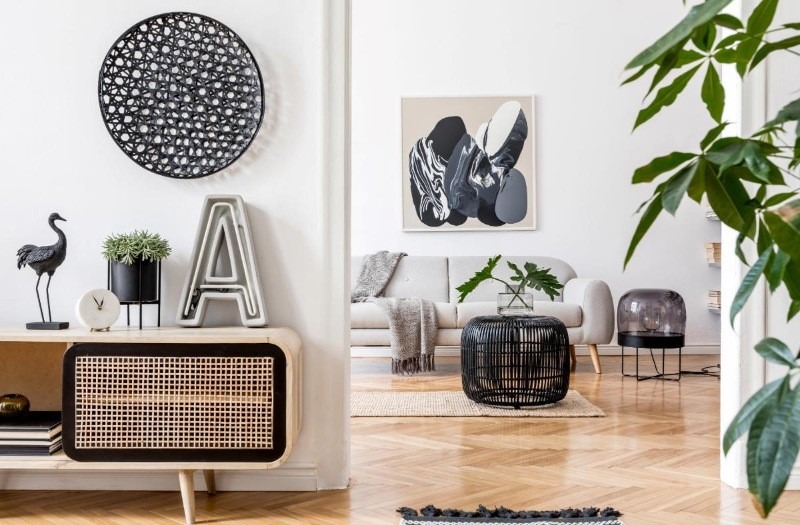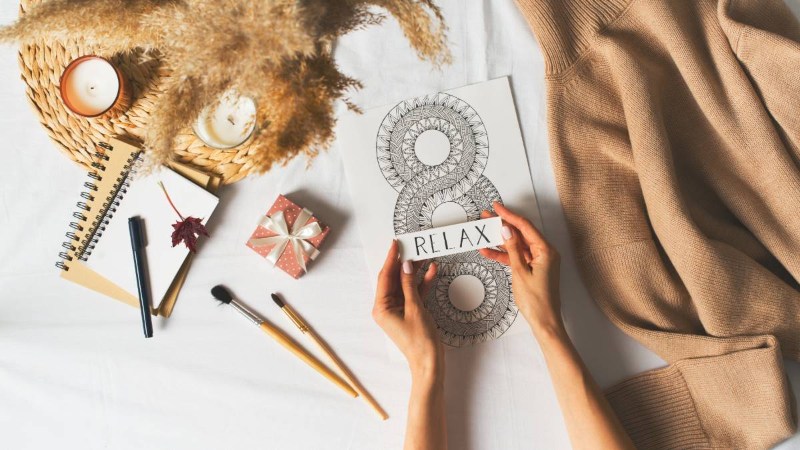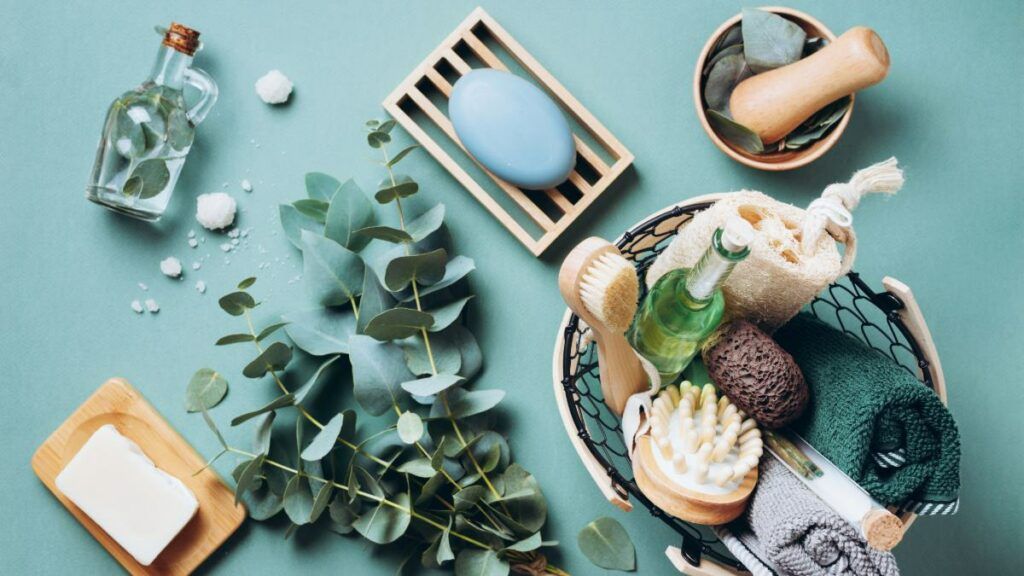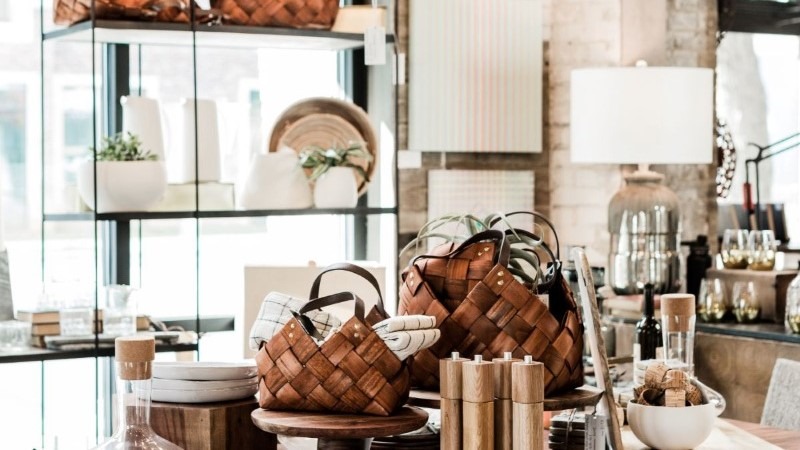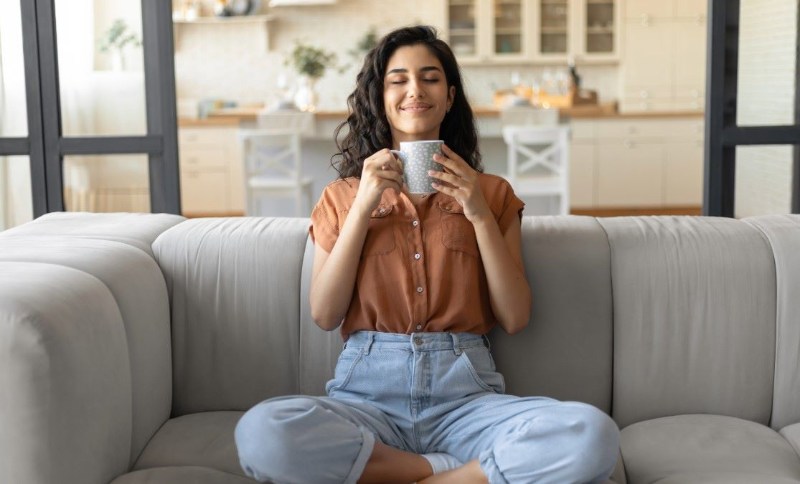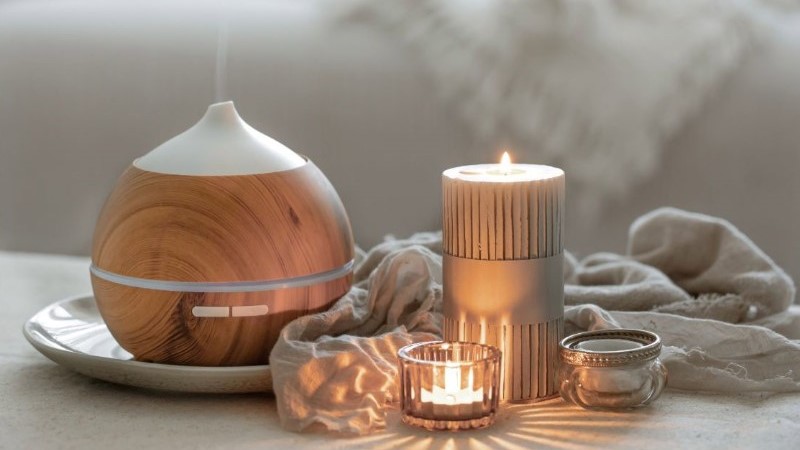Some of the links on this blog may be affiliate links. This means that if you make a purchase through these links, we may earn a small commission at no additional cost to you. We are a participant in the Amazon Services LLC Associates Program, an affiliate advertasing program designed to provide a means for us to earn advertising fees by linking to Amazon.com and affiliate websites.
Look at your living room. Is this a place that really tells a story? Is it a space that wraps you in warmth and inspires you after a tough day? Or maybe it has just became… functional space? A collection of furniture that serves its purpose, but evokes no emotion?
Now imagine something different. Imagine a living room that transports you thousands of miles away, to the heart of vibrant Marrakesh. For bold design lovers, the Moroccan-style living room is a never-ending source of inspiration. It’s the essence of travel and culture, captured in textiles, colors, and shapes that can radically transform the atmosphere of any room.
You don’t need a major renovation or to spend a fortune to capture this magical essence. The key is to understand the philosophy of this style and focus on a few strategic elements. In this guide, we’ll break down the 12 key elements that are essential to achieving an authentic Moroccan look in your home.
Table of Contents
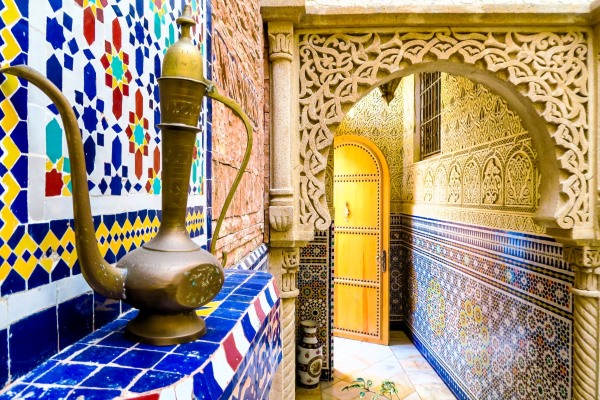
Why is a Moroccan-style living room the perfect choice?
Before we get into the details, let’s consider why this style is so timeless and universal and why this is more than just a trend.
- Warmth and coziness: This style prioritizes comfort above all else. Layers of textiles, soft seating, and a warm color palette create an atmosphere you want to linger in.
- Soul and craftsmanship: In an age of mass production, Moroccan style emphasizes authenticity. Hand-woven rugs, individually forged metal lanterns, and carved wood—each piece tells its own story.
- Sensuality: It appeals to all the senses. The softness of a rug underfoot, the play of light and shadow, the richness of textures, the scent of essential oils—it’s a holistic experience.
- Versatility: It blends perfectly with other aesthetics. Moroccan elements work beautifully in modern, minimalist, or eclectic interiors, adding character. This is the brilliance of modern Moroccan décor.
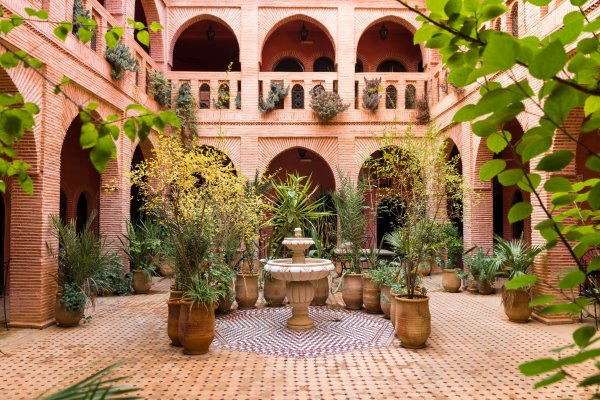
What is a riad and why is its style so desirable?
Let’s draw inspiration from the heart of Moroccan design: riad which means “garden” in Arabic. A riad is a traditional house built around a central garden courtyard, an oasis of tranquility. The 12 elements below are key to capturing that magical riad feeling in your own living room.
The riad style is more than just aesthetics. It shows craftsmanship, natural materials, and harmony with nature. It’s characterized by a wealth of detail, yet simultaneously maintains a sense of space and lightness.
Its combination of luxury and ornateness on the one hand and pure simplicity on the other which makes it so universal and timeless. Whether you prefer classic style or are interested in modern Moroccan décor, you’ll find something for yourself.
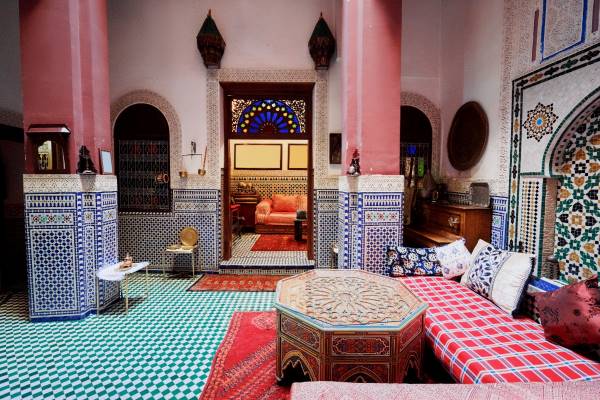
12 Key Elements of Moroccan-Style Living Room
Ready to get started? Let’s dive into the 12 foundational elements that will bring the soul of Moroccan design right into your home.
A Berber Rug: The Foundation Under Your Feet
A Berber rug is the foundation and centerpiece for any Moroccan home design. Forget about thin, synthetic rugs. A true Moroccan-style room needs a thick, colorful rug with soul. The most popular is the Beni Ourain made of thick, natural wool in a cream color with simple black or brown diamond patterns.
How to arrange it?
Invest in a single, large, high-quality rug that will become the heart of the living room. It will define the lounge area. Alternatively, colorful Kilim or patchwork Boucherouite rugs will add energy and an artistic touch to the space.
- With up to five times more material, this rug is exceptionally durable and stands up to everyday wear
- Soft, low-shedding pile provides a cozy, cushioned feel underfoot
- Trendy design seamlessly enhances the Moroccan style living room
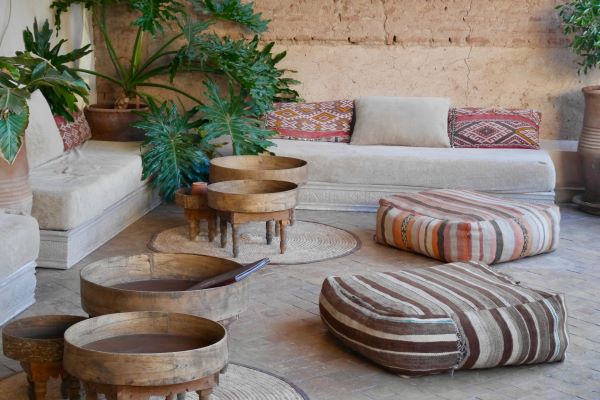
Poufs and Low Seats: Relaxing on the Lower Level
Moroccan hospitality and socializing revolve around communal dining and conversation, often on low seats. This creates an intimate and informal atmosphere. This approach is ideal for your new Moroccan-style living room.
How to arrange it?
Next to the sofa (which can also be lower and deeper), place a few classic, round, or square leather poufs. They are incredibly versatile because they can serve as footstools, additional seats, or tables. Complement them with large floor cushions.
- Made with genuine, high-quality leather, each pouffe is ethically handmade and hand-stitched by local Moroccan artisans
- Arrives stuffed and ready to use
- Can be used as a footstool, an extra seat, or as a unique decorative accent
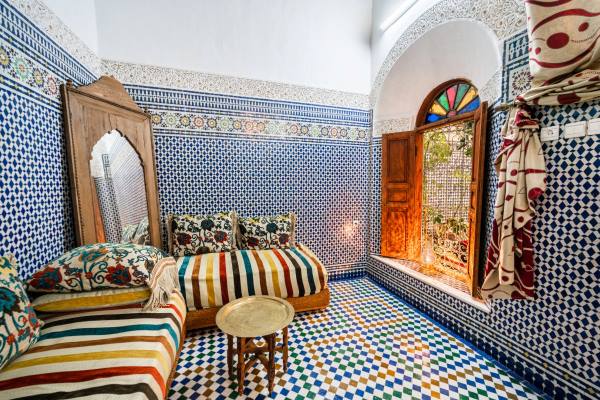
Zellige Tiles: A Mesmerizing Mosaic
These are the absolute foundation of the Moroccan themed living room. Zellige are hand-formed and glazed clay tiles that shimmer in the light with a thousand shades. Each tile is unique, and its imperfections create a vibrant, dynamic surface. In riads, they cover walls, floors, fountains, and columns.
How to arrange it?
You don’t have to cover the entire room in tiles. Use them as a spectacular decorative wall panel in the living room. Even a small accent of Zellige tiles will instantly give your interior an oriental feel.
- Water and steam resistant can be used in kitchens and bathrooms
- A DIY-friendly product that's easy to apply and remove without special tools
- Decals won't fade in sunlight or warp from heat
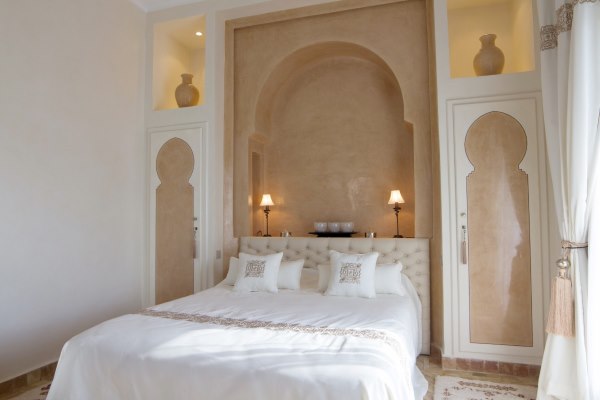
Tadelakt: Walls That Tell a Story
Forget boring, flat white. The walls in Moroccan homes are alive. Traditionally, they are covered with Tadelakt plaster, which has a smooth, satin, and slightly irregular surface. They are waterproof and polished with river stones and olive soap. It is ideal for rooms with high humidity.
How to arrange it?
Tadelakt can be used to cover walls and floors in living rooms and even the area surrounding a bathtub or sink, creating a seamless, monolithic space. Modern textured plasters or paints with a similar satin finish are also attractive options.
Alternatives: If you don’t want to go with Tadelakt, you can opt for textured paints, Venetian clays, or simply warm, saturated colors. Morocco’s color palette includes desert shades (terracotta, ochre, beige), the colors of spices (saffron, cinnamon, turmeric), and deep jewel tones (cobalt blue, emerald green, ruby red).
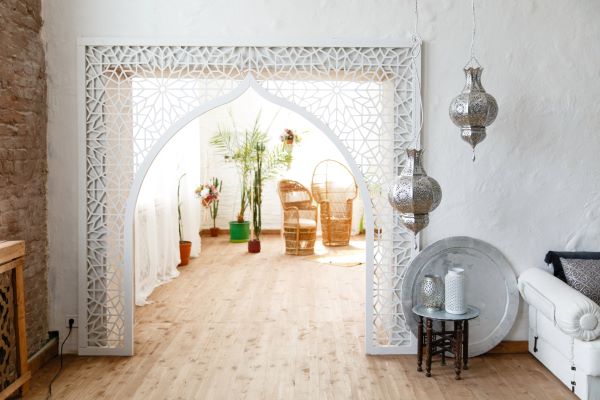
Mashrabiya: Wooden Elements and Craftsmanship
Dark, carved cedar wood is found everywhere in Moroccan interiors. It is used for doors, ceilings, window shutters, and furniture. The distinctive, openwork panels known as mashrabiyas, which filter light, creating a beautiful play of shadows, and provide privacy.
How to arrange it?
If you have space in your new Moroccan-style living room consider a mashrabiya-style screen or a wooden mirror frame to divide the space. Even a small, carved piece can add depth and authenticity to a room. You can choose carved coffee tables, small cabinets, mirrors, or picture frames with carved oriental motifs.
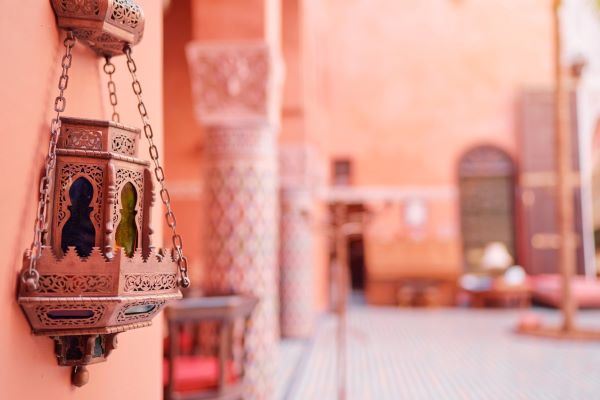
The Magic of Light: Metal Lanterns and Lamps
This is the simplest yet most effective way to easily create a Moroccan atmosphere. Hand-forged, openwork lanterns made of brass or silver cast mesmerizing, lace-like light patterns on the walls and ceiling.
How to arrange it?
Hang one large, spectacular lantern in a focal point of the living room, for example, above the coffee table. Complement the arrangement with smaller table or floor lamps with metal bases and fabric shades that provide a warm, diffused light.
- Exotic and elegant design that is inspired by Moroccan aesthetics
- Made from durable metal with a rustic antique copper finish and sturdy glass panels
- Can be used as a centerpiece in a living room or a charming accent on a porch
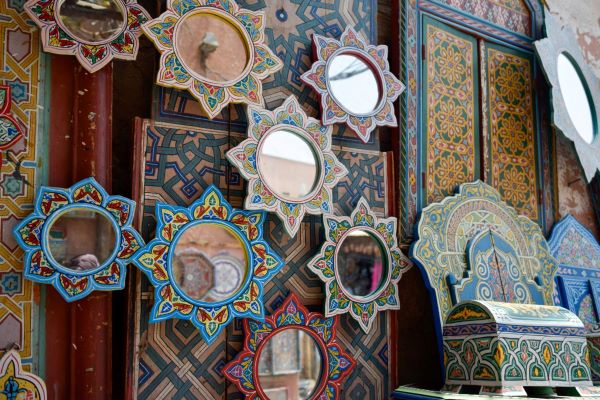
Reflecting Luxury: Ornate Mirrors
Moroccan-style mirrors are true works of art. Their purpose is not only to visually enlarge a space but also to decorate it. They have distinctive shapes (arch, onion, etc.) and feature ornate frames made of metal, wood, or mother-of-pearl.
How to arrange it?
Hang a single, large, striking mirror above a dresser or sofa. It will become like a piece of jewelry for the wall, beautifully reflecting the light from lanterns.
- Unique, and handcrafted design with hundreds of individual glass mosaic pieces
- Elegant, timeless design
- Available in three beautiful Moroccan colors and styles
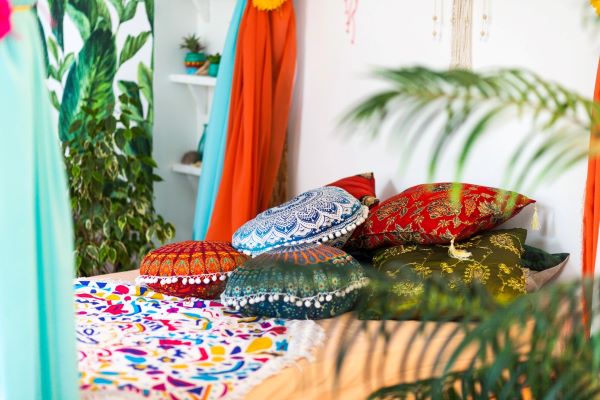
Abundance of Fabrics and Textiles
Moroccans love textiles—velvet, silk, cotton with pom-poms—the list goes on. Other examples include heavy, ornate curtains, bedspreads (especially the famous Moroccan sequined wedding blankets called Handira), and pillowcases with elaborate fringes.
How to arrange it?
Don’t be afraid to mix patterns and textures. Layer pillows in different sizes and colors on the sofa and bed. Hang linen or velvet flowing curtains in the windows. Put a wool throw over the armchair. Textiles are the soul of a cozy Moroccan interior, so take full advantage of them.
- Elegant design and double-sided print adds an pop of color and style to any room
- Durable, elastic, and resistant to pilling, these covers stand up to everyday use
- Fit a wide range of home decor styles and look great on sofas, beds, or patios
A Touch of Oasis: Exotic Plants
Plants are the heart of every traditional Moroccan home. They bring life and color and purify the air, creating the feeling of a garden inside your home. Forget about a single, sad flower on the windowsill. We’re talking about creating a lush, green nook that will bring life to the living room, purify the air, and soothe the senses.
How to arrange it?
Instead of scattering plants throughout the room, create a large grouping of plants in one or two spots, such as in the corner of the living room or next to an armchair. Combine plants of varying heights and shapes to give the impression of a natural, multi-level jungle. Some species that work well are palms (areca, kentia), citrus trees, banana trees, and ficus.
- The Ficus Audrey's elegant form perfectly complements Moroccan décor
- Easy to care for as they need minimal watering and light
- Naturally purifies the air, helping to create a clean, refreshing, and tranquil ambiance
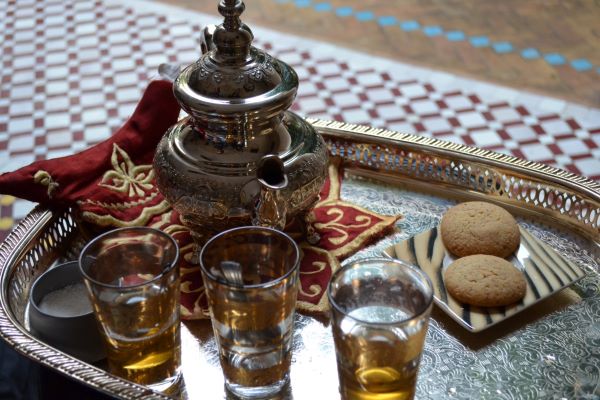
The Social Centerpiece: Coffee Table and Metal Trays
In a Moroccan living room, a coffee table is more than just a piece of furniture. It’s a stage for the tea ritual. Typical features include low, carved wooden tables (often octagonal) or large, round trays made of embossed metal (brass or silver) set on folding wooden legs.
How to arrange it?
Combine these two elements for a classic, luxurious Moroccan effect. Place a large silver tray on a carved wooden table. Finish with an atmospheric arrangement on it: small, ornate tea glasses, an intricate teapot, and a few candles to beautifully reflect off the polished metal.
- Authentic Moroccan craftsmanship
- Made from Alpaca Silver, a rust-resistant blend of metals
- Stunning design makes it a perfect gift
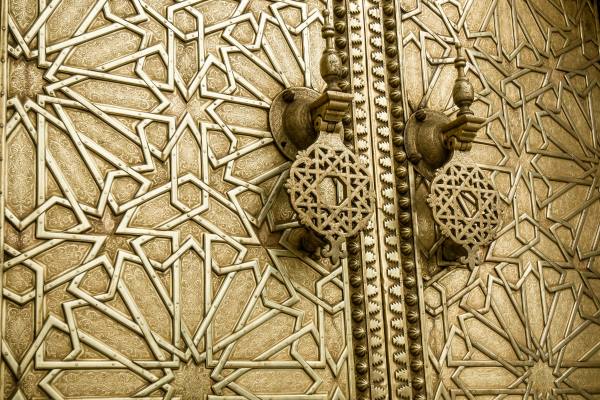
The Art of Pattern: Hypnotic Geometry
The soul of Moroccan design lies in its intricate, repetitive patterns. From complex geometric grids (called girih) to flowing, floral arabesques, these hypnotic motifs create a sense of harmony and infinite beauty. You’ll find them everywhere—in fabrics, carved wood, and metalwork, and their presence weaves the entire style into a cohesive, rhythmic whole.
How to arrange it?
The easiest way to incorporate them is through textiles—choose pillows, throws, or a rug with the characteristic Moroccan clover or symmetrical check motif. For the more daring, an accent wall decorated with a Moroccan pattern creates a spectacular effect. Small accents, such as a mirror framed with bone inlay or an openwork screen, will complete the look.
- High-quality, elegant design and material
- Lightweight with pre-punched holes makes easy to hang
- Wide variety of sizes so perfectly fits for any space
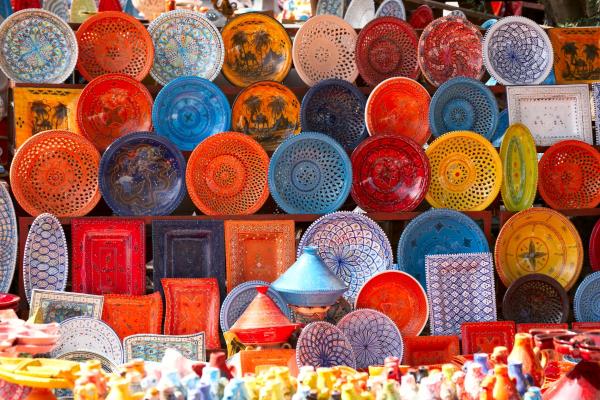
The Finishing Touch: Small Moroccan Accessories
It’s the details that complete the whole thing and give your interior a sense of authenticity. Hand-painted ceramics from cities like Safi and Fez are another hallmark of Moroccan style. Colorful bowls, plates, and, of course, the tagine, the classic Moroccan cooking vessel, with its iconic, conical lid.
How to arrange it?
Place hand-painted ceramics, brass boxes, and decorative tassels on doorknobs, on shelves, and on chests of drawers. Using incense, sandalwood candles, or an orange blossom oil diffuser, let the scents waft through the air. Display beautiful ceramics on open shelves on a sideboard in the dining room. A tagine can be not only a cooking vessel but also a wonderful, sculptural decoration.
- This tagine's design infuses food with rich, authentic flavors, bringing Morocco directly to your home
- Each pot is a work of art, ethically crafted by women artisans
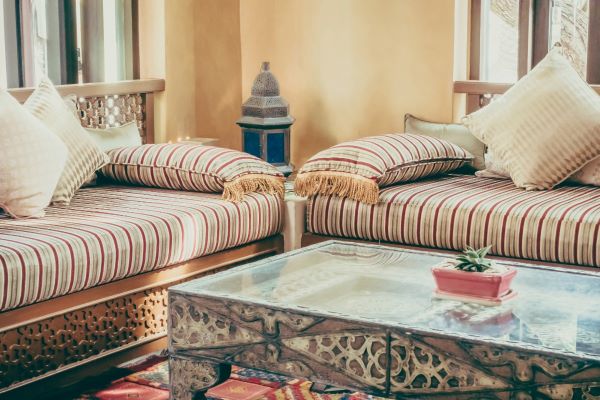
How to combine riad style with modern Moroccan décor?
We’ve already learned about the 12 elements of riad style, so how do you apply them to your modern Moroccan-themed home?
The key to a modern Moroccan décor is a masterful balance of design. It’s a philosophy that subtly draws on tradition and combines it with the clean lines of contemporary design.
Neutral color palette: Instead of intense wall colors, choose off-white, beige, gray, or warm sand tones. This will highlight the rich patterns and textures of Moroccan accessories.
Less is more: Instead of filling the room with dozens of trinkets, choose a few, yet spectacular elements. One large lantern, one authentic rug, and a few pillows—this will be enough to create the desired atmosphere.
Mix styles: In a Moroccan-style living room, most of the elements pair perfectly with simple, modern furniture, such as Scandinavian or boho styles. A carved coffee table looks great next to a minimalist sofa. And finally, a Beni Ourain rug perfectly offsets the austerity of an industrial loft.
Your Personal Sanctuary
Creating a Moroccan riad-style interior isn’t just about following the latest trends. It’s about creating a space that’s personal, warm, and soulful. It’s an invitation to slow down, celebrate craftsmanship, and surround yourself with beauty that has a story behind it.
Whether you decide on a complete transformation or just to incorporate a few of these elements, remember that the essence of this style is to create your own private sanctuary. Experiment, mix things up, and find your own path to Marrakesh.

